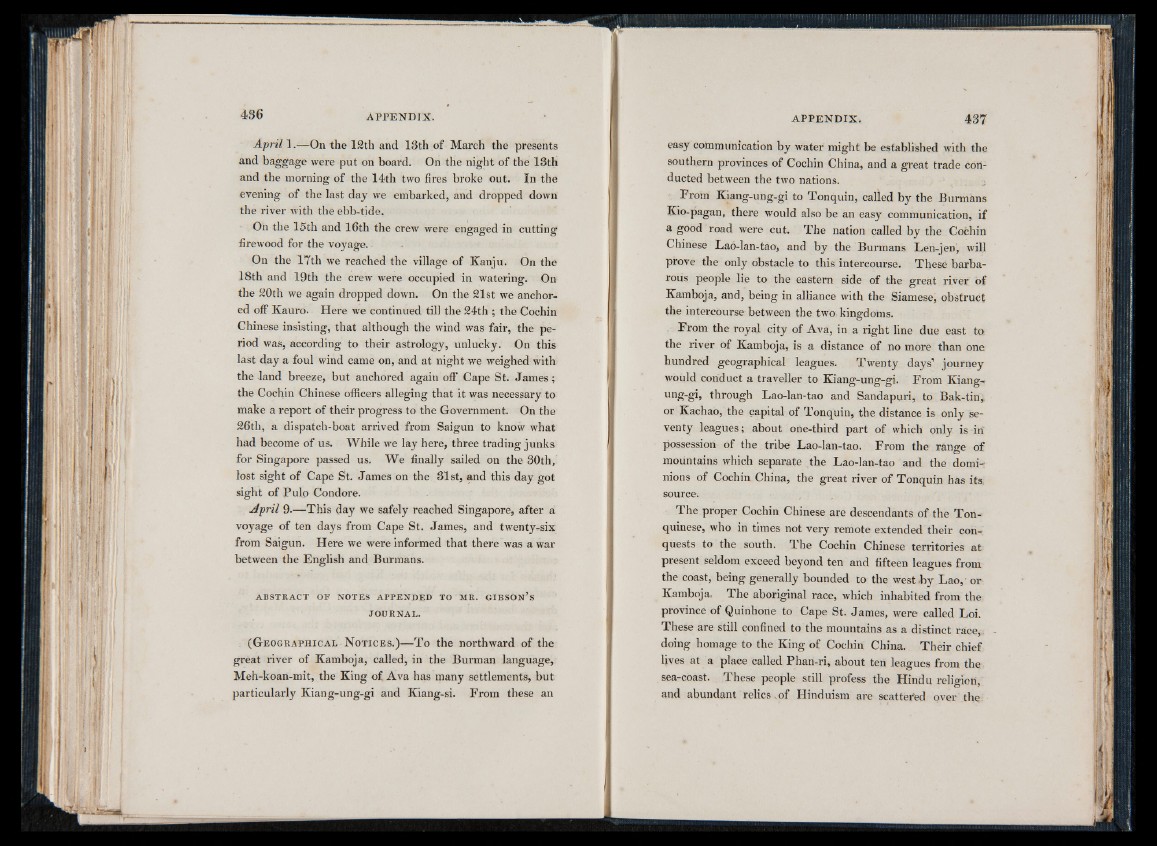
A p r il 1.—On the 12th and 13th of March the presents
and baggage were put on board. On the night of the 13th
and the morning of the 14th two fires broke out. In the
evening o f the last day we embarked, and dropped down
the river with the ebb-tide.
On the 15th and 16th the crew were enog aog ed in cuttinog
firewood for the voyage.
On the 17th we reached the village of Kanju. On the
18th and 19th the crew were occupied in watering. On
the 20th we again dropped down. On the 21st we anchored
off Kauro. Here we continued till the 24th ; the Cochin
Chinese insisting, that although the wind was fair, the period
was, according to their astrology, unlucky. On this
last day a foul wind came on, and at night we weighed with
the land breeze, but anchored again off Cape St. J am e s;
the Cochin Chinese officers alleging that it was necessary to
make a report of their progress to the Government. On the
26th, a dispatch-boat arrived from Saigun to know what
had become of us. While we lay here, three trading junks
for Singapore passed us. W e finally sailed on the 30th,
lost sight o f Cape St. James on the 31st, and this day got
sight of Pulo Condore.
A p r il 9.— This day we safely reached Singapore, after a
voyage of ten days from Cape St. James, and twenty-six
from Saigun. Here we were informed that there was a war
between the English and Burmans.
A B S T R A C T O F N O T E S A P P E N D E D TO M R . G IB S O N ’ S
JO U R N A L .
( G e o g r a p h i c a l N o t i c e s . ) — To the northward o f the
great river o f Kamboja, called, in the Burman language,
Meh-koan-mit, the King of. A va has many settlements, but
particularly Kiang-ung-gi and Kiang-si. From these an
easy communication by water might be established with the
southern provinces o f Cochin China, and a great trade conducted
between the two nations.
From Kiang-ung-gi to Tonquin, called by the Burmans
Kio-pagan, there would also be an easy communication, if
a good road were cut. The nation called by the Cochin
Chinese Lao-lan-tao, and by the Burmans Len-jen, will
prove the only obstacle to this intercourse. These barbarous
people lie to the eastern side o f the great river o f
Kamboja, and, being in alliance with the Siamese, obstruct
the intercourse between the two kingdoms.
From the royal city of Ava, in a right line due east to
the river of Kamboja, is a distance o f no more than one
hundred geographical leagues. Twenty days’ journey
would conduct a traveller to Kiang-ung-gi. From Kiang-
ung-gi, through Lao-lan-tao and Sandapuri, to Bak-tin,
or Kachao, the capital o f Tonquin, the distance is only seventy
leagues; about one-third part of which only is in
possession o f the tribe Lao-lan-tao. From the range of
mountains which separate the Lao-lan-tao and the dominions
o f Cochin China, the great river o f Tonquin has its
source.
The proper Cochin Chinese are descendants o f the Ton-
quinese, who in times not very remote extended their conquests
to the south. The Cochin Chinese territories at
present seldom exceed beyond ten and fifteen leagues from
the coast, being generally bounded to the west-by Lao, or
Kamboja, The aboriginal race, which inhabited from the
province of Quinhone to Cape St. James, were called Loi.
These are still confined to the mountains as a distinct race,,
doing homage to the King of Cochin China. Their chief
lives at a place called Phan-ri, about ten leagues from the
sea-coast. These people still profess the Hindu religion,
and abundant relics v of Hinduism are scattered over the